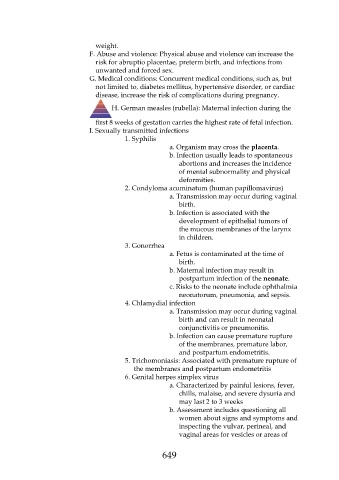Page 649 - Saunders Comprehensive Review For NCLEX-RN
P. 649
weight.
F. Abuse and violence: Physical abuse and violence can increase the
risk for abruptio placentae, preterm birth, and infections from
unwanted and forced sex.
G. Medical conditions: Concurrent medical conditions, such as, but
not limited to, diabetes mellitus, hypertensive disorder, or cardiac
disease, increase the risk of complications during pregnancy.
H. German measles (rubella): Maternal infection during the
first 8 weeks of gestation carries the highest rate of fetal infection.
I. Sexually transmitted infections
1. Syphilis
a. Organism may cross the placenta.
b. Infection usually leads to spontaneous
abortions and increases the incidence
of mental subnormality and physical
deformities.
2. Condyloma acuminatum (human papillomavirus)
a. Transmission may occur during vaginal
birth.
b. Infection is associated with the
development of epithelial tumors of
the mucous membranes of the larynx
in children.
3. Gonorrhea
a. Fetus is contaminated at the time of
birth.
b. Maternal infection may result in
postpartum infection of the neonate.
c. Risks to the neonate include ophthalmia
neonatorum, pneumonia, and sepsis.
4. Chlamydial infection
a. Transmission may occur during vaginal
birth and can result in neonatal
conjunctivitis or pneumonitis.
b. Infection can cause premature rupture
of the membranes, premature labor,
and postpartum endometritis.
5. Trichomoniasis: Associated with premature rupture of
the membranes and postpartum endometritis
6. Genital herpes simplex virus
a. Characterized by painful lesions, fever,
chills, malaise, and severe dysuria and
may last 2 to 3 weeks
b. Assessment includes questioning all
women about signs and symptoms and
inspecting the vulvar, perineal, and
vaginal areas for vesicles or areas of
649

